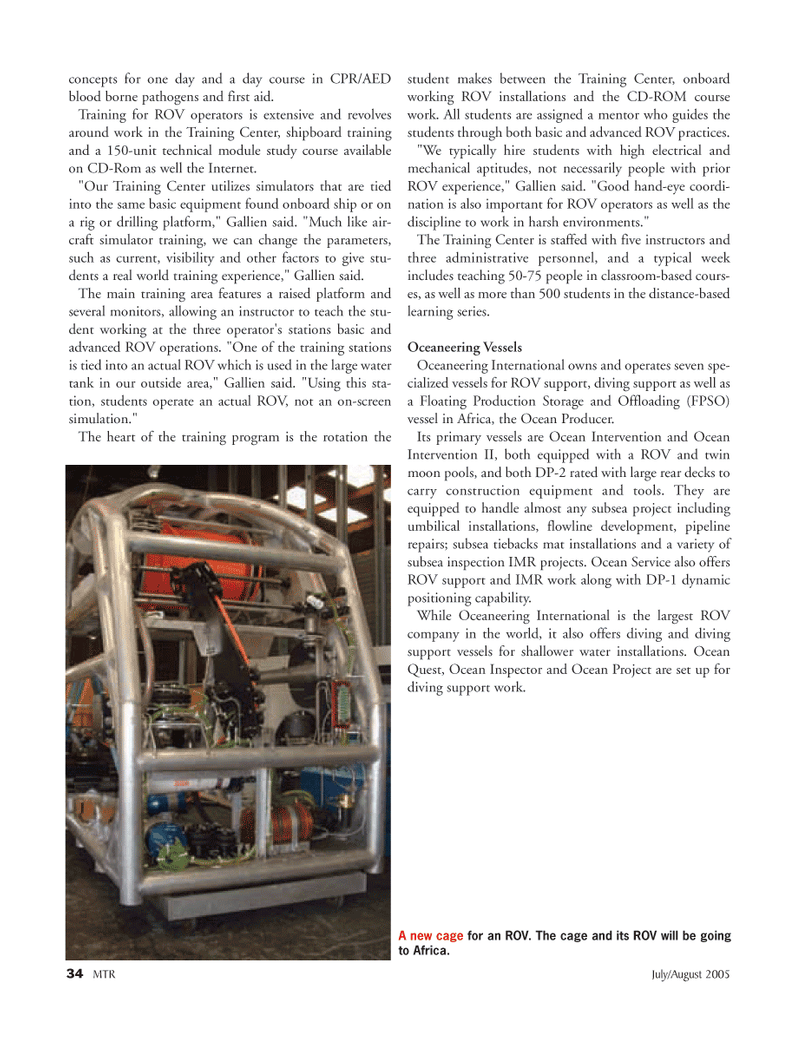
Page 33: of Marine Technology Magazine (July 2005)
Read this page in Pdf, Flash or Html5 edition of July 2005 Marine Technology Magazine
concepts for one day and a day course in CPR/AED blood borne pathogens and first aid.
Training for ROV operators is extensive and revolves around work in the Training Center, shipboard training and a 150-unit technical module study course available on CD-Rom as well the Internet. "Our Training Center utilizes simulators that are tied into the same basic equipment found onboard ship or on a rig or drilling platform," Gallien said. "Much like air- craft simulator training, we can change the parameters, such as current, visibility and other factors to give stu- dents a real world training experience," Gallien said.
The main training area features a raised platform and several monitors, allowing an instructor to teach the stu- dent working at the three operator's stations basic and advanced ROV operations. "One of the training stations is tied into an actual ROV which is used in the large water tank in our outside area," Gallien said. "Using this sta- tion, students operate an actual ROV, not an on-screen simulation."
The heart of the training program is the rotation the student makes between the Training Center, onboard working ROV installations and the CD-ROM course work. All students are assigned a mentor who guides the students through both basic and advanced ROV practices. "We typically hire students with high electrical and mechanical aptitudes, not necessarily people with prior
ROV experience," Gallien said. "Good hand-eye coordi- nation is also important for ROV operators as well as the discipline to work in harsh environments."
The Training Center is staffed with five instructors and three administrative personnel, and a typical week includes teaching 50-75 people in classroom-based cours- es, as well as more than 500 students in the distance-based learning series.
Oceaneering Vessels
Oceaneering International owns and operates seven spe- cialized vessels for ROV support, diving support as well as a Floating Production Storage and Offloading (FPSO) vessel in Africa, the Ocean Producer.
Its primary vessels are Ocean Intervention and Ocean
Intervention II, both equipped with a ROV and twin moon pools, and both DP-2 rated with large rear decks to carry construction equipment and tools. They are equipped to handle almost any subsea project including umbilical installations, flowline development, pipeline repairs; subsea tiebacks mat installations and a variety of subsea inspection IMR projects. Ocean Service also offers
ROV support and IMR work along with DP-1 dynamic positioning capability.
While Oceaneering International is the largest ROV company in the world, it also offers diving and diving support vessels for shallower water installations. Ocean
Quest, Ocean Inspector and Ocean Project are set up for diving support work. 34 MTR July/August 2005
A new cage for an ROV. The cage and its ROV will be going to Africa.
MTR#1 (33-48).qxd 7/19/2005 9:52 AM Page 34

 32
32

 34
34
